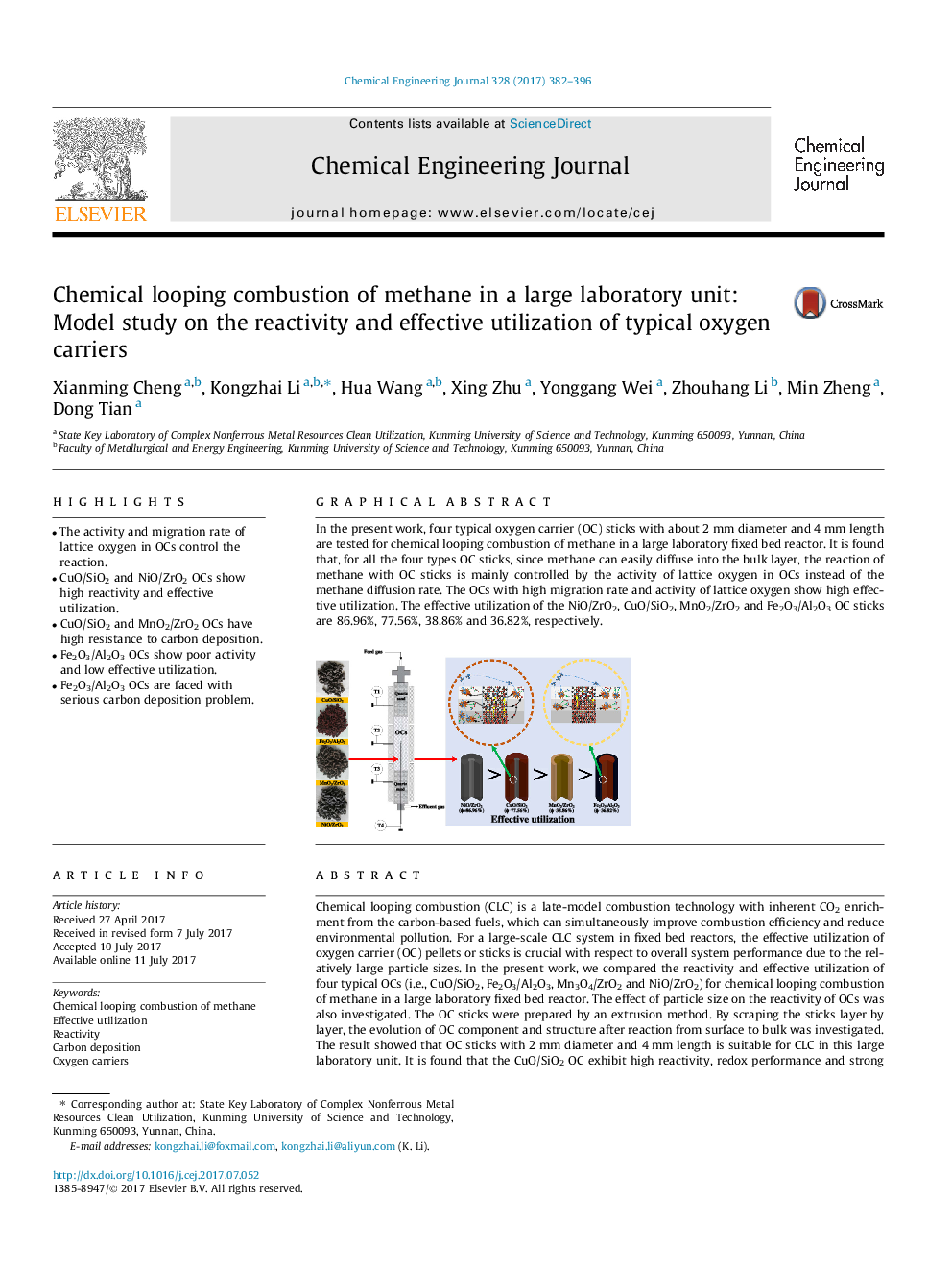| Article ID | Journal | Published Year | Pages | File Type |
|---|---|---|---|---|
| 6465242 | Chemical Engineering Journal | 2017 | 15 Pages |
â¢The activity and migration rate of lattice oxygen in OCs control the reaction.â¢CuO/SiO2 and NiO/ZrO2 OCs show high reactivity and effective utilization.â¢CuO/SiO2 and MnO2/ZrO2 OCs have high resistance to carbon deposition.â¢Fe2O3/Al2O3 OCs show poor activity and low effective utilization.â¢Fe2O3/Al2O3 OCs are faced with serious carbon deposition problem.
Chemical looping combustion (CLC) is a late-model combustion technology with inherent CO2 enrichment from the carbon-based fuels, which can simultaneously improve combustion efficiency and reduce environmental pollution. For a large-scale CLC system in fixed bed reactors, the effective utilization of oxygen carrier (OC) pellets or sticks is crucial with respect to overall system performance due to the relatively large particle sizes. In the present work, we compared the reactivity and effective utilization of four typical OCs (i.e., CuO/SiO2, Fe2O3/Al2O3, Mn3O4/ZrO2 and NiO/ZrO2) for chemical looping combustion of methane in a large laboratory fixed bed reactor. The effect of particle size on the reactivity of OCs was also investigated. The OC sticks were prepared by an extrusion method. By scraping the sticks layer by layer, the evolution of OC component and structure after reaction from surface to bulk was investigated. The result showed that OC sticks with 2Â mm diameter and 4Â mm length is suitable for CLC in this large laboratory unit. It is found that the CuO/SiO2 OC exhibit high reactivity, redox performance and strong resistance to carbon deposition formation. The existence of Cu2O in the deep layers of the reduced CuO/SiO2 sticks suggests that the CuO even in the bulk of sticks can react with methane. The effective utilization of the CuO/SiO2 OC is 77.56%. NiO/ZrO2 OC also shows high reactivity and redox performance for CLC with methane, and its effective utilization is as high as 86.96%. However, the presence of metallic Ni during the reaction will catalyze the methane cracking into carbon deposition and H2. Fe2O3/Al2O3 and Mn3O4/ZrO2 OCs represent relatively low reactivity for methane oxidation. The obtained effective utilizations for the Fe2O3/Al2O3 and Mn3O4/ZrO2 sticks are only 36.82% and 38.86%, respectively, indicating that these two OCs with large particle size cannot react with methane completely. It is also noted that the Mn3O4/ZrO2 OC sticks possess strong resistance to carbon deposition formation, while the Fe2O3/Al2O3 OC sticks are faced with serious carbon deposition problem. For all the OC sticks, since methane can easily diffuse into the bulk layer, the reaction of methane with OC sticks is mainly controlled by the migration rate and activity of lattice oxygen in OCs.
Graphical abstractIn the present work, four typical oxygen carrier (OC) sticks with about 2Â mm diameter and 4Â mm length are tested for chemical looping combustion of methane in a large laboratory fixed bed reactor. It is found that, for all the four types OC sticks, since methane can easily diffuse into the bulk layer, the reaction of methane with OC sticks is mainly controlled by the activity of lattice oxygen in OCs instead of the methane diffusion rate. The OCs with high migration rate and activity of lattice oxygen show high effective utilization. The effective utilization of the NiO/ZrO2, CuO/SiO2, MnO2/ZrO2 and Fe2O3/Al2O3 OC sticks are 86.96%, 77.56%, 38.86% and 36.82%, respectively.Download high-res image (187KB)Download full-size image
